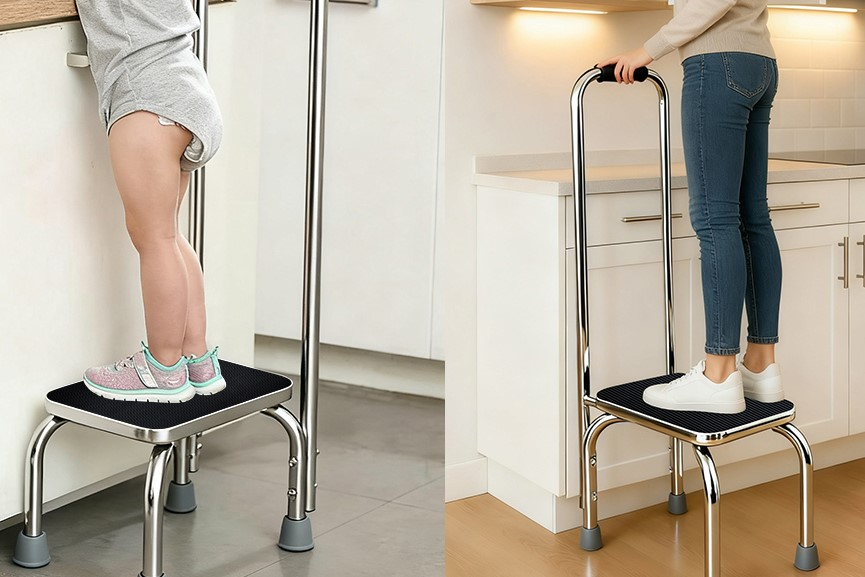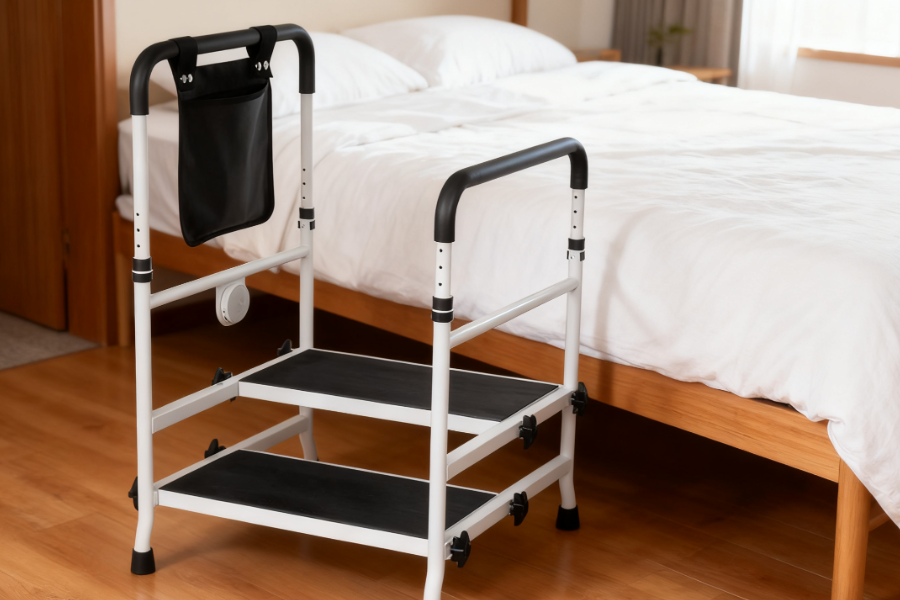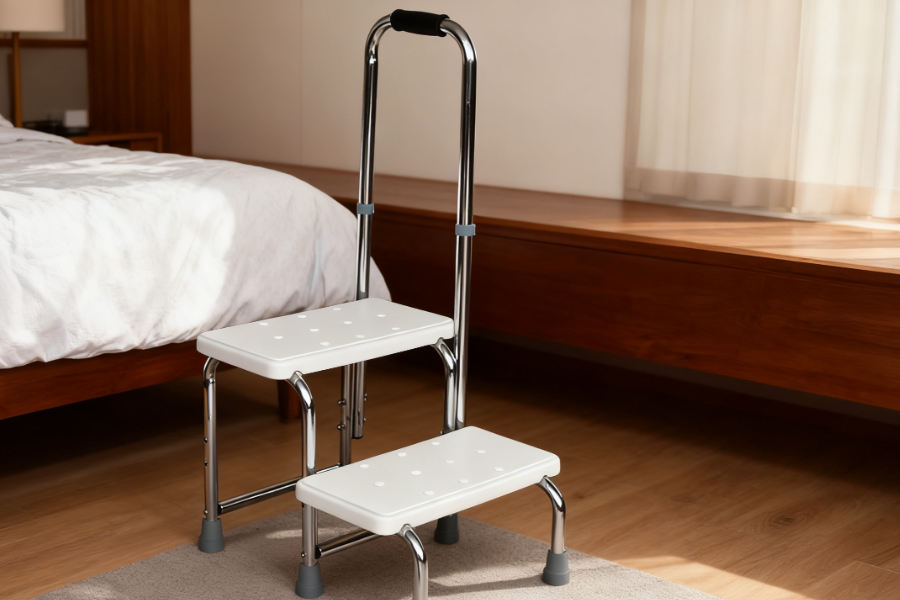Step stools are key for elderly and disabled folks, aiding with tasks like grabbing items from shelves or stepping into bathtubs. A flimsy stool can lead to falls, so safety is crucial. Global standards set clear rules to make sure stools are tough, steady, and simple to use. For B2B buyers, picking stools that meet these rules builds trust and keeps users safe. Buyers can explore Beiqin and OEM/ODM services for custom, quality solutions that boost independence.

Global safety rules keep users safe by setting standards for how stools handle stress. These cover material strength, balance, and practical features, making sure stools work well in real life. For businesses, choosing compliant stools cuts risks and builds customer confidence.
Standards like ISO13485 and ISO9001 guide quality for medical and assistive tools. They call for tough tests on weight support, material strength, and wear resistance. Compliant stools stay reliable in homes or care homes, handling daily use without breaking down.
Certifications like FDA, CE, RoHS, MDR, UKCA, and TGA (Australia) show a stool meets strict safety and health rules for global markets. These prove the product has been tested for dependability, giving buyers confidence in its performance.
A stool that misses standards risks recalls or accidents, hurting a company’s reputation. Certified stools offer reliability, lower legal risks, and appeal to clients who value safety. Choosing compliant products meets the demand for trusted assistive tools.
A stool’s lifespan and safety hinge on its durability. Strong materials resist wear, rust, and heavy weight, making them ideal for users with mobility needs. Buyers should pick stools built for frequent use in tough settings.
Aluminum alloys and high-density PP resin are used in quality stools. Light yet tough, they support users well.
Bathrooms and kitchens are damp, which can harm stools. Rust-proof materials, like anodized aluminum, keep stools safe and working, even in wet places. This makes them last longer.
A safe stool holds at least 300 pounds, per CE and FDA rules. This suits many users, from seniors to those with disabilities, keeping them steady during use.
A shaky stool risks falls. Smart design keeps stools steady, stopping tips or slips. Buyers should look for products that keep users safe, even on uneven floors.
Rubber feet or suction pads grip surfaces well, cutting slip risks. Some work better in wet conditions, vital for bathroom stools where floors get slick.
Handles shaped for natural grips make stepping easier. Adjustable or cushioned handles, like on the Padded Large Foot Step Stool, help users balance without strain.

Wide bases and low centers of gravity keep stools grounded. Strong frames, tested for shifting weight, stay steady even if a user leans suddenly.
Safety isn’t just about structure; it’s about user needs. Stools for seniors or disabled people focus on accessibility and comfort, making tasks easier and safer.
Stools with 5–8 height settings fit different users. This helps reach shelves or bathtubs without stretching too far, keeping users safe.
Textured or cushioned surfaces stop feet from slipping. Drainage holes on step stools prevent water buildup, ensuring grip for users with balance issues.
Cushioned handles ease hand pressure and improve grip. Washable pads keep things clean, especially in care settings where hygiene matters.
A safe stool should be practical and fit into users’ lives. Features like portable and easy cleaning save space and effort, ideal for homes or care facilities.
Lightweight stools, under 10 pounds, are easy to move and store in small spaces while staying strong.
Streamlined surfaces resist stains and mold. Washable covers keep stools hygienic in hospitals or homes.
Stools that don’t need tools for setup or height changes save time. Snap-on parts or hand-turned knobs make adjustments quick for users or caregivers.
Picking a reliable manufacturer means focusing on safety and quality. Beiqin, with 15 years in assistive devices, runs a 20,000m² factory in Zhejiang. Their 210+ workers and 60+ machines produce 6,000+ units daily. Certified by ISO13485, ISO9001, FDA, CE, UKCA, RoHS, MDR, and TGA, their stools meet global standards.
Beiqin’s 15 years of work on tools for seniors and disabled people ensures products like the Double Step Stool with Armrests meet real needs. They’ve served brands like Homcom and Walgreens in 50+ countries, showing deep know-how.

Beiqin offers single and double-step stools for homes, hospitals, or rehab centers. Their adjustable, cushioned models suit varied mobility needs. With 180,000 units in stock, buyers get products fast.
Beiqin’s OEM/ODM services allow custom designs, like logos or colors. Their stools, tested for 10,000+ weight cycles, use rust-proof aluminum and germ-resistant PP resin. Certified by BSCI and ISO45001, they offer reliable products with good support.
Q1: What certifications should a safe step stool have?
A: Look for FDA, CE, RoHS, MDR, UKCA, or TGA certifications. These show the stool meets tough safety and health rules for reliability.
Q2: How much weight should a step stool support?
A: A good stool supports at least 300 pounds, per CE and FDA standards, making it safe for many users.
Q3: Why is a non-slip base critical for step stools?
A: Rubber feet or suction pads stop slips on wet or uneven floors, cutting fall risks, especially in bathrooms.
Q4: Can step stools be adjusted for different users?
A: Yes, stools with 5–8 height settings fit various heights, making tasks like reaching shelves safer.
Step stools are key for elderly and disabled folks, aiding with tasks like grabbing items from shelves or stepping into bathtubs. A flimsy stool can lead to falls, so safety is crucial. Global standards set clear rules to make sure stools are tough, steady, and simple to use. For B2B buyers, picking stools that meet these rules builds trust and keeps users safe. Buyers can explore Beiqin and OEM/ODM services for custom, quality solutions that boost independence.

Global safety rules keep users safe by setting standards for how stools handle stress. These cover material strength, balance, and practical features, making sure stools work well in real life. For businesses, choosing compliant stools cuts risks and builds customer confidence.
Standards like ISO13485 and ISO9001 guide quality for medical and assistive tools. They call for tough tests on weight support, material strength, and wear resistance. Compliant stools stay reliable in homes or care homes, handling daily use without breaking down.
Certifications like FDA, CE, RoHS, MDR, UKCA, and TGA (Australia) show a stool meets strict safety and health rules for global markets. These prove the product has been tested for dependability, giving buyers confidence in its performance.
A stool that misses standards risks recalls or accidents, hurting a company’s reputation. Certified stools offer reliability, lower legal risks, and appeal to clients who value safety. Choosing compliant products meets the demand for trusted assistive tools.
A stool’s lifespan and safety hinge on its durability. Strong materials resist wear, rust, and heavy weight, making them ideal for users with mobility needs. Buyers should pick stools built for frequent use in tough settings.
Aluminum alloys and high-density PP resin are used in quality stools. Light yet tough, they support users well.
Bathrooms and kitchens are damp, which can harm stools. Rust-proof materials, like anodized aluminum, keep stools safe and working, even in wet places. This makes them last longer.
A safe stool holds at least 300 pounds, per CE and FDA rules. This suits many users, from seniors to those with disabilities, keeping them steady during use.
A shaky stool risks falls. Smart design keeps stools steady, stopping tips or slips. Buyers should look for products that keep users safe, even on uneven floors.
Rubber feet or suction pads grip surfaces well, cutting slip risks. Some work better in wet conditions, vital for bathroom stools where floors get slick.
Handles shaped for natural grips make stepping easier. Adjustable or cushioned handles, like on the Padded Large Foot Step Stool, help users balance without strain.

Wide bases and low centers of gravity keep stools grounded. Strong frames, tested for shifting weight, stay steady even if a user leans suddenly.
Safety isn’t just about structure; it’s about user needs. Stools for seniors or disabled people focus on accessibility and comfort, making tasks easier and safer.
Stools with 5–8 height settings fit different users. This helps reach shelves or bathtubs without stretching too far, keeping users safe.
Textured or cushioned surfaces stop feet from slipping. Drainage holes on step stools prevent water buildup, ensuring grip for users with balance issues.
Cushioned handles ease hand pressure and improve grip. Washable pads keep things clean, especially in care settings where hygiene matters.
A safe stool should be practical and fit into users’ lives. Features like portable and easy cleaning save space and effort, ideal for homes or care facilities.
Lightweight stools, under 10 pounds, are easy to move and store in small spaces while staying strong.
Streamlined surfaces resist stains and mold. Washable covers keep stools hygienic in hospitals or homes.
Stools that don’t need tools for setup or height changes save time. Snap-on parts or hand-turned knobs make adjustments quick for users or caregivers.
Picking a reliable manufacturer means focusing on safety and quality. Beiqin, with 15 years in assistive devices, runs a 20,000m² factory in Zhejiang. Their 210+ workers and 60+ machines produce 6,000+ units daily. Certified by ISO13485, ISO9001, FDA, CE, UKCA, RoHS, MDR, and TGA, their stools meet global standards.
Beiqin’s 15 years of work on tools for seniors and disabled people ensures products like the Double Step Stool with Armrests meet real needs. They’ve served brands like Homcom and Walgreens in 50+ countries, showing deep know-how.

Beiqin offers single and double-step stools for homes, hospitals, or rehab centers. Their adjustable, cushioned models suit varied mobility needs. With 180,000 units in stock, buyers get products fast.
Beiqin’s OEM/ODM services allow custom designs, like logos or colors. Their stools, tested for 10,000+ weight cycles, use rust-proof aluminum and germ-resistant PP resin. Certified by BSCI and ISO45001, they offer reliable products with good support.
Q1: What certifications should a safe step stool have?
A: Look for FDA, CE, RoHS, MDR, UKCA, or TGA certifications. These show the stool meets tough safety and health rules for reliability.
Q2: How much weight should a step stool support?
A: A good stool supports at least 300 pounds, per CE and FDA standards, making it safe for many users.
Q3: Why is a non-slip base critical for step stools?
A: Rubber feet or suction pads stop slips on wet or uneven floors, cutting fall risks, especially in bathrooms.
Q4: Can step stools be adjusted for different users?
A: Yes, stools with 5–8 height settings fit various heights, making tasks like reaching shelves safer.
Share To:
related articles
You can contact us any way that ls convenient for you.